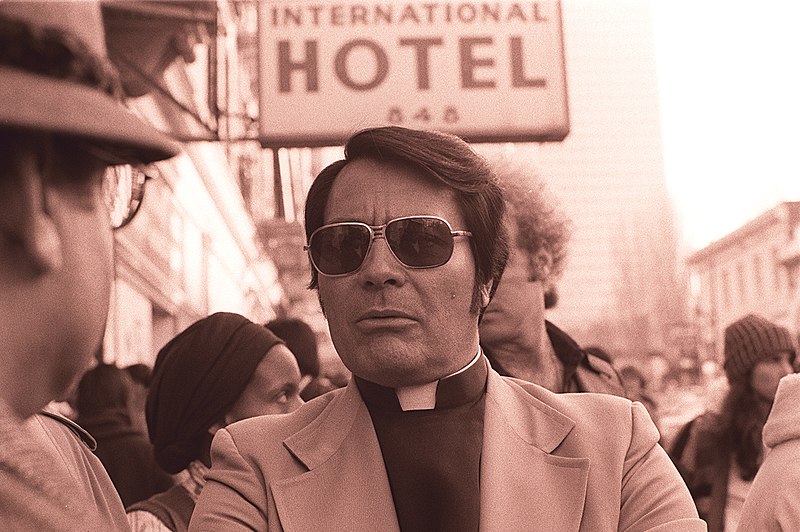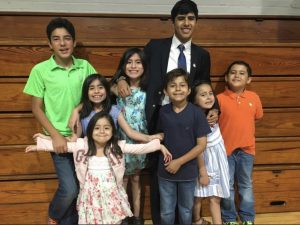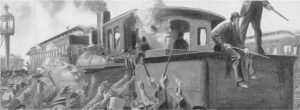Have you ever heard of the Kool-Aid Massacre? Where one mind-controlling, manipulating man led to hundreds to their deaths? Throughout the 20th century, numerous cults shaped America’s history in terrifying ways. Some of the most memorable have been the Manson Family, Heaven’s Gate, and The People’s Temple Agricultural Project. It takes a second when someone hears The People’s Temple to remember what happened, but usually mentioning the Jonestown Massacre helps them recall the terrors that happened that day.
Jim Jones, a preacher, started The People’s Temple Agricultural Project in the mid-1950s while residing in Indianapolis. The goal of the organization was to fight against racism and poverty, and Jones’ followers were primarily African Americans. Jones believed in Christianity and socialism. His organization “…was dedicated to the pursuit of social justice along Marxist lines.”1 He thought it was unfair that the rich were able to be happy and living a wonderful life while the poor or racially discriminated endured a life of hardships. He believed everyone deserved equality. Jones called his mission “apostolic socialism” through Marxist theology. He invented this term as a way to describe his church as something that used faith healings alongside an upbeat style from black churches. He began to become more demanding of his followers, insisting they call him “father” or “dad.”2 This was the first step in how Jones’ demands would become more of a problem.

Jones eventually moved the organization to Redwood, California because of his growing population of followers. He began calling the organization a church. Eventually he created churches in Los Angeles and San Francisco, where he later moved the his headquarters. He opened up churches in black communities around San Francisco to gain more followers.3 Jones became so popular that he was elected a chairman of the San Francisco Housing Authority Commission.4 This gave him more power and notoriety among the general population. With this much power, expressing his ideas increased the followers he gained. He climbed his way up and made himself a powerful, controlling man through his charisma and ideology. This led to the rise of popularity of his church and influenced even more people to join.
Cults became increasingly popular in America throughout its history because people have found them appealing to their beliefs and values. Some join due to the cult believing in the same values or having the same desires for changes to political or racial relations. Many cults are considered as religious or political based on their values. There are 600 different alternative religions in America and Canada alone that can be considered cults.5Many of the cults in the past represented some part of a countercultural movement happening within America during the late 20th century. John R. Hall, an American author, wrote, “the radical Left and counterculture’s emergence in the 1960s did not go unchallenged. Rather there was a broad-based reaction- on cultural, social, and political fronts.”6 The appearance of cults became more apparent during this time due to the political and social movements that were happening in America. People who were thought of as a minority or people from a lower social class wanted change. These people wanted change so badly that they willingly believed in anyone charismatic enough and who promised to give them what they wanted whether it be money or equality.7
As the People’s Temple grew, the larger population of San Francisco became worried about the church and its preachings. The citizens thought it was strange that the church employed armed guards at all times.8 Accusations spread about the organization participating in financial fraud and abusing some of its members. New West Magazine described Jones as a sexual predator and drug user. The magazine also stated that Jones faked ceremonies where he healed his followers, and he scammed his followers out of their money.9

While being investigated for these accusations and crimes, Jones decided to move his church to Guyana in South America after discussing with his followers. One of his followers suggested Guyana because of the black, socialist leaders in charge of the country. Jones and his followers thought because of that, they would be able to live peacefully in Guyana.10 After all Jones’ followers moved to Guyana, family members became concerned since Jones would not allow followers to communicate with their families in the United States. These family members begged California congressman Leo Ryans to take a trip to Jonestown and bring home their family members. The congressman agreed to take a trip to figure out what was happening after the death of a former temple member who previously spoke about leaving the church. The congressman’s suspicions rose, and he felt he needed to investigate for himself. The trip started out going extremely well. Jones welcomed Congressman Leo Ryan. Jones invited him to have food and attend a musical rehearsal. According to sources, all the followers forcefully pretended to be happy and pretended everything was going fine while the congressman was there. Some families who asked congressman Ryan to take them back to the United States with him. Jones became furious and secretly devised a plan that was the starting point of the deaths for many.11
By promising their followers a new way of life, cult leaders gain a type of control over members’ minds and lives themselves. There is a stereotype within cults that leaders use brainwashing or mind control on their followers in order to fulfill their selfish wants.12 Some cult members lie and pretend to have psychic readings and psychic healings. This leads many people to believe in these leaders and start giving complete devotion to them. Followers begin to see their leader as a “Living God.” This leads to followers enduring physical pain and abuse to show their dedication. There are several ways followers expressed this in the past such as depriving themselves of sleep or not eating the proper nutrients needed for their body.13 If a follower refuses to comply with showing their devotions in such ways or simply want to live the group, leaders execute them. One survivor notes how he wanted to leave, and he received a choice of either being shot or drink poison. Although he escaped, not many were as lucky.14 Eventually this leads to the last devotion any follower gives their leader, their life.
Due to the concern that arose, Congressman Leo Ryan agreed that the people wanting to go home may go with him. Jones showed no anger while Congressman Ryan was there. As soon as he left to his plane, Jones ordered for all of the ones leaving to be killed. There was nine members who went to shoot everyone who decided to leave. Everyone died including Congressman Leo Ryan, who was shot over twenty times.15 Not long after, Jones planned a mass-suicide for all the members to join in. The majority of the members participated in drinking poisoned punch. The children, unaware, drank the poisoned punch first, and then the adults drank the punch next. Armed guards stood ready to shoot if members refused to participate. Guards shot all of the members who tried running away. This resulted in over 900 deaths.16 Jones coined the event as “revolutionary suicide,” and it received the nickname “Kool-Aid Massacre.” These events took a toll on American citizens as it was one of the largest mass killings in history at the time.17

The sad truth is that some of these American cults ended in the death of hundreds. As a last step to show their devotion to their leader, followers willing participate in committing suicide or committing mass murder. This could be done in numerous way such as either injecting themselves or others with poison or killing and taking the lives of innocent people. 18 The followers believe they are proving themselves worthy to their leader by giving this last devotion of taking their lives or others. This ultimately gives the leader the last control over the follower’s lives.
Even though the event that took place was a tragedy, some members escaped and survived the mass-suicide. Jim Jones was found dead with a shot to his head, but there is no evidence to know if he killed himself or if someone else killed him. The rest of the members that resided in California eventually ended the organization. The members that survived went on to tell their stories and how Jim Jones controlled and acted.19 The actions of Jim Jones led to the loss of hundreds American lives in total. Even though these events happened forty-one years ago, it still is one of the most tragic events to happened in America’s history.
- Salem Press Biographical Encyclopedia, 2019, s.v. “Jonestown and the People’s Temple,” by Joseph P Byren. ↵
- Richard Cavendish, “The Jonestown Mass Suicide,” History Today 58, no. 11 (2008): 13. ↵
- Salem Press Biographical Encyclopedia, 2019, s.v. “Jonestown and the People’s Temple,” by Joseph P Byren. ↵
- Wikipedia, 2019, s.v. “Jonestown.” https://en.wikipedia.org/wiki/Jonestown. ↵
- Robert Emmet Long, Religious Cults in America (New York: H.W. Wilson, 1994), 75. ↵
- John R. Hall, “Jonestown in the Twenty-First Century,” Society 41, no. 2 (2004) 9. ↵
- James R. Lewis, Cults in America : A Reference Handbook (California: ABC-CLIO, 1998) 18. ↵
- Salem Press Biographical Encyclopedia, 2019, s.v. “Jonestown and the People’s Temple,” by Joseph P Byren. ↵
- Richard Cavendish, “The Jonestown Mass Suicide,” History Today 58, no. 11 (2008): 13. ↵
- Wikipedia, 2019, s.v. “Jonestown.” https://en.wikipedia.org/wiki/Jonestown. ↵
- Wikipedia, 2019, s.v. “Jonestown.” https://en.wikipedia.org/wiki/Jonestown. ↵
- James R. Lewis, Cults in America : A Reference Handbook (California: ABC-CLIO, 1998) 39. ↵
- Robert Emmet Long, Religious Cults in America (New York: H.W. Wilson, 1994), 16. ↵
- Robert Emmet Long, Religious Cults in America (New York: H.W. Wilson, 1994) 17. ↵
- Wikipedia, 2019, s.v. “Jonestown.” https://en.wikipedia.org/wiki/Jonestown. ↵
- Salem Press Biographical Encyclopedia, 2019, s.v. “Jonestown and the People’s Temple,” by Joseph P Byren. ↵
- Wikipedia, 2019, s.v. “Jonestown.” https://en.wikipedia.org/wiki/Jonestown. ↵
- Robert Emmet Long, Religious Cults in America (New York: H.W. Wilson, 1994), 17. ↵
- Wikipedia, 2019, s.v. “Jonestown.” https://en.wikipedia.org/wiki/Jonestown. ↵



49 comments
Donna Ainsworth
I am someone who has always had a great deal of interest in cults, from how they came to be to what ended up happening. The People’s Temple is one that I have specifically had a great interest in over the years. It was interesting to me to learn that he was a huge advocate when it came to the rights of African Americans and other marginalized groups, so much so that he managed to get elected as a chairman of the San Francisco Housing Authority Commission. It is sad to see that he went from fighting for the rights of people to becoming deranged and causing the deaths of hundreds of his followers.
Richard Moreno
Jim Jones was a truly evil man. It goes to show the level psychological manipulation that many people are capable of, and what happens when they use that ability for the detriment of humanity. I enjoyed the article because it concisely explained the events leading up to the infamous Jamestown massacre. The story of cults, and especially cult leaders, are usually very interesting cases. Jones is no exception. He was a narcissist, master manipulator, and really had a sadistic desire to control masses of people. I’m no psychoanalyst but even I can tell – the guy had some serious issues.
Matthew Fabela
This article was lengthy which I really liked! Jim Jones is probably one of my personal favorite cult leaders because his original beliefs were actually favorable to the people, he was pushing for racial equality and human rights in a non violent way which is great until he started to do all the bad stuff then he was not so great. I feel like had he not gone down the path of being a cult leader he would have probably done really progressive things for the black community but unfortunately he chose the latter of the two and let his ego,the drugs and his fame get to him.
Aleea Costilla
I had heard of this story prior to reading the article, but I thoroughly enjoyed the background information that was provided about stereotypes of cults. This event is a classic example of how these organizations come to be and are horrendously successful. For instance, Jim Jones cleverly uses a vulnerable population (African Americans) as a target in this cult, as they are likely to be susceptible to his conflictual ideologies. I found particularly interesting how you mentioned Congressman Leo Ryan and his attempt to aid Jones’ followers, to display how the event was not unnoticed in the eyes of politicians.
Cayden Garcia
It is crazy to think about how one’s want to change can lead to death. I think the Jonestown massacre is the best representation of that. As cult leaders go, Jim Jones was manipulative and sociopathic. To see yourself as better than others is not the way of a leader, it is the way of a crazy person. You did a great job describing him and what he did to his followers.
I do have one question. How many years after his death did his “churches” continue to go on? Also, did anyone else try to “lead” the followers after his death?
Good job on the article!
Lucia Saks
This story is insane. The idea of one person being able to convince that many people to do what he wants and to lead them is crazy. The idea behind the cult seemed like a good message of equality but was taken to extremes and ultimately led to their untimely deaths after drinking the Kool-aid. Also the fact that so many were murdered and not allowed to leave is horrific. Its crazy how susceptible people are to cult like messages and how common cults were in this time really makes you stop and think about your own susceptibility to ideas such as these.
Emilia Caballero Carmona
Hey Hannah, I really liked your article because you explained the events very well. I had heard about the “Kool Aid Massacre” before, but the other articles I read about it were a little confusing since the events leading to the massacre were very complex and unusual. The events that happened really saddened me because like you explained, many innocent people have gave up their entire life following the orders of a leader who doesn’t even care about them. I like that you talk about there being hundreds of cult like organizations in the United States and throughout its history and I hope that with this we raise awareness and not let history repeat itself.
Aaron Sandoval
This paper was well written and did a good job of covering the events of Jonestown as well as giving information on cults and how they develop mass followings. I have heard of the tragedy, and have looked into it very briefly, and you did a good job of covering the events especially with the inclusion of Congressman Leo Ryans. I was not aware of his involvement and how visiting the town resulted in his death, and possibly sparked the mass suicide.
Margaret Cavazos
I have heard of the Jonestown Massacre but never looked into what happened. This article showed the horror of how many people were killed, both while trying to leave the cult, and because of the manipulation of the leader. It is terrible that one person could convince so many people to die. I was not aware that that many cults existed in the time period and it is astonishing that they were allowed to escalate to the point of such destruction of life. It seems that the leaders of these cults also primarily preyed on vulnerable people that needed something to believe in. The fact that they were taken advantage of is sad, especially knowing that initially they wanted civil rights and less racism.
Amanda Shoemaker
I remember watching a documentary about this several years back, Jonestown: The Life and Death of Peoples Temple. The entire story is almost unbelievable. This article does a very good job telling the story and how it happened. The worst part is that the kids drank the Kool aid first not knowing what was going to happen to them. Also, Congressman Leo Ryan being shot over 20 times after trying to protect people that wanted out of the cult is horrifying. I’m really glad that I decided to read this article but at the same time, thinking about all of those horrible things that happened is very difficult.